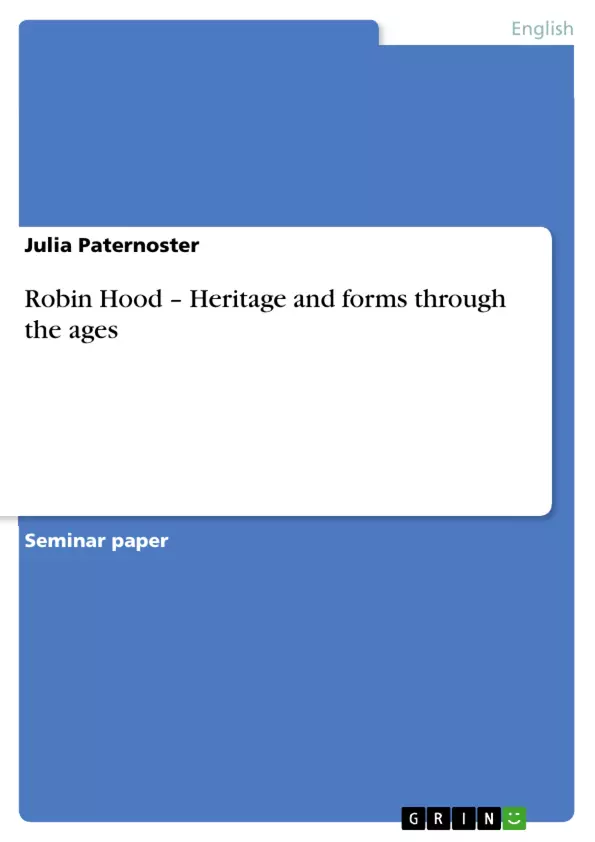"Many men speak of Robin Hood who never drew his bow: so runs the old proverb, suggesting
both the popularity and the mystery of the Robin Hood tradition. A modern equivalent might be:
Many people know about Robin Hood but have never read the texts." (Knight 1997, xiii)
This quotation is a very good evaluation of the status of knowledge considering
the Robin Hood related texts. Most people only know Robin Hood from various film
adaptations. They are not aware of the fact that the Robin Hood legend has now
endured in written form for over 600 years.
When speaking of Robin Hood we think of attributes like "outlaws", "rob the rich
to feed the poor", "Maid Marian", "arrow and bow" or "noble man" as the common
features of the Robin Hood myth. In fact, only few of these stereotypes are a part of
the early written tradition as it will be illustrated in the following.
[...]
Table of Contents
- Introduction
- The Robin Hood Myth
- First written evidence and early ballads: 14th - 17th century
- Performances of many kinds celebrating Robin Hood: 15th-18th century
- Popular Narratives and Film: 20th century
- Conclusion
Objectives and Key Themes
This work aims to explore the evolution of the Robin Hood myth through the ages, examining how it has been interpreted and adapted in various forms of media, from early ballads to contemporary films. The objective is to trace the development of the legend and its enduring appeal in popular culture. Key themes include:- The origins and development of the Robin Hood legend
- The historical and cultural context of the legend
- The portrayal of Robin Hood in various media, including ballads, plays, and films
- The evolving nature of the Robin Hood myth and its enduring appeal
- The political and social implications of the Robin Hood legend
Chapter Summaries
- Introduction: This chapter introduces the Robin Hood legend and its enduring popularity, acknowledging the widespread knowledge of the myth despite the limited familiarity with its textual origins. It also highlights the evolution of the legend, moving from early ballads to modern film adaptations, and introduces key themes and concepts explored in subsequent chapters.
- The Robin Hood Myth: This chapter delves into the origins of the Robin Hood myth, examining the scant historical evidence and exploring the various interpretations of the figure's identity and the motivations behind the legend. It discusses the presence of individuals named Robin Hood in historical records and the possible connection to real-life outlaws and fugitives.
- First written evidence and early ballads: 14th – 17th century: This chapter explores the earliest written mentions of Robin Hood, highlighting the significance of William Langland's *Piers Plowman* and its portrayal of Robin Hood's popularity in the 14th century. It examines various 15th-century chronicles that feature Robin Hood and sheds light on the content of early ballads, emphasizing the differences between those early versions and the later romanticized versions of the legend.
Keywords
The Robin Hood myth, popular culture, ballads, historical sources, outlaw, legend, medievalism, adaptation, film, media, storytelling, social commentary, political context, cultural representation.- Quote paper
- Julia Paternoster (Author), 2003, Robin Hood – Heritage and forms through the ages , Munich, GRIN Verlag, https://www.grin.com/document/117614



